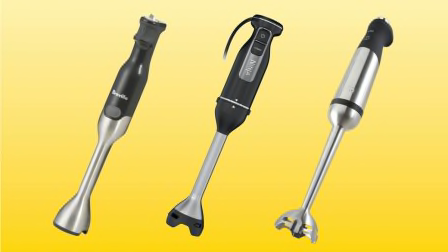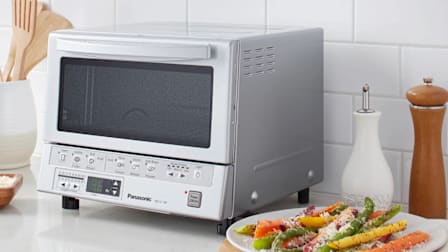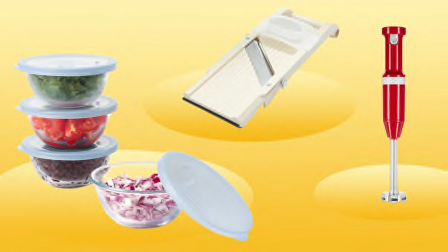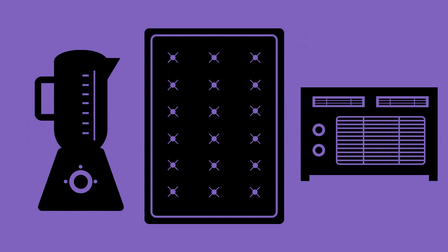How to Use an Immersion Blender
A handheld blender is a magic wand for your kitchen, useful for puréeing soups, emulsifying sauces, and whipping up smoothies
When you shop through retailer links on our site, we may earn affiliate commissions. 100% of the fees we collect are used to support our nonprofit mission. Learn more.
Crushing ice for a frozen cocktail? Reach for a full-sized blender. Need a quick smoothie for your morning commute? Break out your personal-sized blender, then hit the road with its on-the-go jar. But if soup or mashed potatoes are on the menu, an immersion blender is what you need. It does the trick whether you’re serving scrambled eggs, a peach smoothie, or butternut squash soup.
What Is an Immersion Blender?
An immersion blender is a handheld, electric mixing appliance with a handle-grip top, baton-like shaft and a spinning blade covered by a protective guard at the bottom. Due to its long cylindrical shape, it’s often called a stick blender or hand blender. Plug-in or cordless, it’s designed to complement your countertop blender, not replace it.
“An immersion blender combines the attributes of an automatic blender or mixer with the manual stirring motion of a spoon,” says Ginny Lui, who oversees CR’s blender testing.
What Is an Immersion Blender Used For?
This small appliance is used for emulsifying hard-to-blend liquids (think oil and water), whipping concoctions in a bowl, or mixing soups, stews, or sauces in a stovetop stock pot. They’re also ideal for whipping eggs, blending pancake batter, and puréeing thick soups like lobster bisque or split pea.
Some come with attachments like whisks, beaters, milk frothers, choppers, and jars, which expand their repertoire to salad dressings, milkshakes, cappuccinos, baby foods, salsas, and even peanut butter.
At CR, we test immersion blenders by how well they blend frozen peaches, strawberries, and yogurt for smoothies, and how well they purée soup vegetables in water. We also test each blender’s power in revolutions per minute.
How to Use an Immersion Blender
Using an immersion blender is simple. Before turning the appliance on, submerge the blade completely into the food or drink you want to mix. Move the blender around the container to mix all the contents. Keep the blade submerged to avoid splatters.
“It’s simple,” says Lui. “Just switch the device on and swirl the stick around to blend. It’s more manual work than a full-sized blender, but it’s also less cleanup.”
Tips for Using an Immersion Blender
Avoid pot scratches. Even though it has a blade guard, avoid scraping the bottom or sides of the pot, especially if it has a non-stick surface. One way to do this is by slightly angling the blender or tilting the pot. Be careful if the food you are mixing is hot, however.
Why Should You Use an Immersion Blender?
Convenience: Immersion blenders fit in the palm of your hand, with simple controls operated by the press of a button. Jar-less, they’re also easy to clean compared with other blender types.
Portability: Handheld blenders travel well. If you hit the road for Thanksgiving, you can pack an immersion blender to help whip up the gravy at dinnertime.
Easy storage: Their small size makes immersion blenders easy to stash in a kitchen cabinet or drawer.
Stovetop use: Blending directly in a stock pot eliminates the need to transfer hot liquids, like soup, to a countertop blender.
“An immersion blender is efficient for big batches of sauces, hummus, vinaigrettes, and some soups,” says Jose Luis Falcon, executive chef at Elia Mediterranean Restaurant in East Rutherford, N.J., where he makes up to 20 liters of sauce at a time. “For example, we use the stick blender for aioli, a garlic mayonnaise emulsion that we infuse with roasted pepper and herbs for more flavor.”
But Falcon says immersion blenders aren’t the best choice for superfine purées, so he uses a full-sized Vitamix blender for soup bases and a mixer for mashed potatoes. “For mashed and sweet potatoes, you want to whip them up so they’re not mushy,” he says. “We also use a Vitamix blender for smooth and creamy soups. But if you want it chunky, you can use an immersion blender.”
Which Brand Makes the Best Immersion Blender?
CR currently rates 11 immersion blenders, including models from All-Clad, Amazon Basics, Blendtec, Breville, Cuisinart, GE, KitchenAid, Mueller, Ninja, NutriBullet, and Vitamix.
Below, in alphabetical order, you’ll find the three top-rated immersion blenders according to our tests, all of which earn CR’s recommendation. For more blenders, review our comprehensive ratings. And for shopping advice, check out our blender buying guide.
@consumerreports This is the immersion blender showdown you didn’t know you needed 🔥🍓🥤 Hit the 🔗 in our profile for more on the top-performing immersion blenders #smoothie #kitchengadgets #immersionblender #foodtiktok #kitchentok
♬ original sound - Consumer Reports - Consumer Reports





























